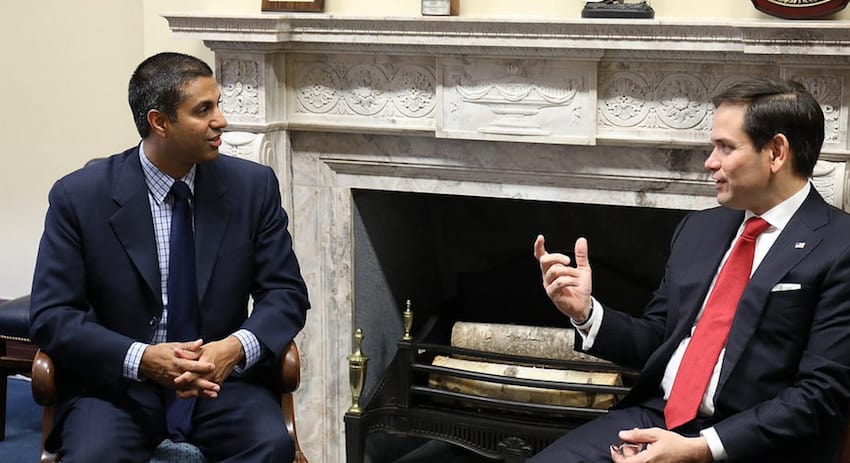Analysis of the FCC’s Broadband Internet Benchmark of 100/20 Mbps, and why it changes over time.
The official FCC broadband definition is currently a minimum of 100 Mbps download and 20 Mbps upload. This standard was introduced by FCC Chairwoman Jessica Rosenworcel in 2024 after nearly a decade of holding the previous standard of 25 Mbps download, 3 Mbps upload. The benchmark increase was based partly on “standards now used in multiple federal and state programs (such as the BEAD Program and multiple USF programs), consumer usage patterns, and what is actually available from and marketed by internet service providers.”
Are you a journalist or researcher writing about this topic?
Contact us and we'll connect you with a broadband market expert on our team who can provide insights and data to support your work.
The recent update is a pivotal move in the context of modern broadband initiatives such as the Broadband Equity, Access, and Deployment (BEAD) Program, among others. This enhancement from the previous standard underscores the federal commitment to not just improving the quantity but also the quality of broadband access across the nation, particularly in underserved and unserved areas.
FCC Broadband Definition Over Time
| Year Adopted | Minimum Download | Minimum Upload | FCC Commissioner |
|---|---|---|---|
| 2024 | 100 Mbps | 20 Mbps | Jessica Rosenworcel, D |
| 2015 | 25 Mbps | 3 Mbps | Tom Wheeler, D |
| 2010 | 4 Mbps | 1 Mbps | Julius Genachowski, D |
| 1996 | 200 Kbps | 200 Kbps | William Kennard, D |
Past Broadband Benchmark Changes
The FCC has updated its broadband benchmark periodically over the years. Here is a brief overview of each of these changes, and the political forces surrounding them.
2018: Disagreements Over FCC Broadband Definition

FCC Chairman Ajit Pai earned a shower of negative media attention in recent months for his suggestion that a mobile broadband benchmark of 10 Mbps should be sufficient to mark consumers as “served” in the semi-annual Broadband Progress Report. In his proposal, Pai cited the widespread access to high-speed mobile as potentially sufficient for basic Internet access. In the past, subscribers were only considered “served” if they had access to both 25 Mbps download / 3 Mbps upload wired broadband and mobile connectivity.
This would have been the first-ever reduction in the FCC standard for consumers to be considered “served” with broadband Internet. However, contrary to what was reported widely in the media, this would not be a replacement for the wired broadband 25/3 Mbps down/up standard. It would have, however, caused the percentage of Americans considered “covered” by the FCC to jump dramatically.
In the FCC’s own words:
We propose to maintain the current speed benchmark of 25 Mbps download and 3 Mbps upload (25 Mbps/3 Mbps) for fixed broadband, and we also seek comment about other potential benchmarks.
2015: 25 Mbps download, 5 Mbps Upload
The previous adjustment in 2015, establishing a minimum speed of 25 Mbps for downloads and 3 Mbps for uploads, aligned with the priorities of the Obama administration to enhance regulatory oversight within the telecommunications sector. This era marked a significant focus on digital inclusivity, highlighted by the administration’s critical evaluation of the telecom industry’s efforts to expand broadband access, as evidenced by its unique issuance of a “failing” grade in the annual Broadband Progress Report. President Obama emphasized that the initiative was not merely about improving internet speeds or telecommunication reliability but rather about bridging the digital divide and ensuring comprehensive access to digital resources across the United States.
This move also reflected the emphasis placed by Tom Wheeler, the FCC Chairman appointed in 2013, on addressing the “digital divide,” particularly in rural communities. By raising the minimum required speeds for broadband, the action inadvertently spotlighted the challenges of inadequate coverage in these areas, underscoring the ongoing disparities in digital connectivity and the need for enhanced infrastructure and policy measures to mitigate this divide.
2010: 4 Mbps download, 1 Mbps Upload
The FCC upgraded the minimum definition for wired broadband to 4 Mbps download and 1 Mbps upload in 2010. It’s worth noting that the only other major change in the broadband benchmark took place under Chairman Julius Genachowski of the early Obama administration. In their 2010 Broadband Progress Report, the FCC justified changing the broadband definition as necessary to accommodate video alongside basic browsing:
It [4 Mbps download, 1 Mbps upload] is the minimum speed required to stream a high-quality —even if not high-definition—video while leaving sufficient bandwidth for basic web browsing and e-mail, a common mode of broadband usage today that comports directly with section 706’s definition of advanced telecommunications capability.
Prior to the 2010 change, video streaming was widely viewed as a luxury. Considering the advancing popularity of video conferencing and remote teamwork, it’s not surprising that the FCC broadband definition would be upgraded.

Image via Gage
Skidmore/Flickr
Interestingly, the FCC’s own speed guidelines define the minimum speed/bandwidth needed for video conferencing as 1 Mbps.
Impact of the New Standard
The new broadband standard has several potential implications for various stakeholders:
For Internet Service Providers
Some ISPs may need to upgrade their infrastructure to meet the new standards over the long term, which could involve significant investment in fiber-optic networks and other technologies capable of delivering higher speeds.
For Consumers
Higher minimum speeds eventually translate to better user experiences, enabling smoother streaming, faster downloads, and more reliable connections for multiple devices. It also opens up bandwidth in anticipation of increased needs due to emerging technologies like artificial intelligence and the internet of things.
For Government and Policy Makers
The new definition will help to guide the allocation of federal funding for broadband deployment, particularly in underserved and rural areas. It also influences regulatory measures aimed at ensuring equitable access to high-speed internet.
The Statistic Is Mightier Than The Sword
Overall, FCC Broadband Reports have been as much about the conversation they start as the data inside.
Shifting benchmarks such as the FCC broadband definition can allow an administration to create seeming favorable or unfavorable results according to the regulatory agenda of the party in power. Under Obama, changing benchmarks drew attention to the digital divide and every single report concluded that broadband was not being deployed “in a reasonable and timely fashion.”
Conservative parties tend to conclude that broadband is being deployed fast enough, and that increased scrutiny and regulation isn’t the answer to increasing competition. This could be seen in the Trump administration’s proposal to lower coverage standards, which would have created more favorable statistics to include in progress reports.
Regardless of which side you fall on, it’s been frustrating to see that most actual upgrades to rural networks come either as a requirement in contested merger agreements, or from small fixed wireless providers and community networks.

